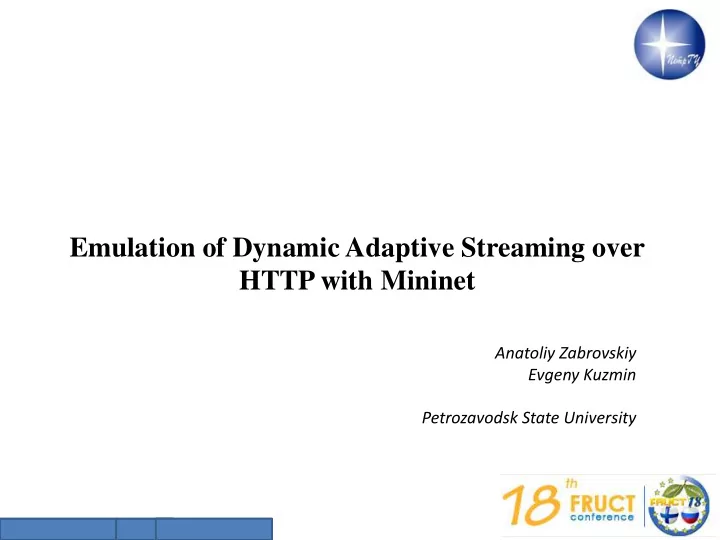

Emulation of Dynamic Adaptive Streaming over HTTP with Mininet Anatoliy Zabrovskiy Evgeny Kuzmin Petrozavodsk State University
Video streaming Video streaming is becoming more and more popular technology for media content delivery over the Internet. Streaming protocols: • HLS (from Apple) • RTMP (from Adobe) • RTSP • HDS • Smooth (from Microsoft) • DASH
MPEG-DASH Dynamic Adaptive Streaming over HTTP (DASH), also known as MPEG-DASH, is the first bit rate adaptive HTTP based solution which became an international standard in 2012. YouTube and Netflix have started deploying MPEG-DASH which means that the format will play an important role in streaming. The advantage of using HTTP is that the ordinary web servers with a caching capability can be used for streaming video.
MPEG-DASH How to test new algorithms and Dash-based services? Which Emulator to use?
MPEG-DASH and Mininet MPEG-DASH will soon be more actively used in real systems along with such new technologies and approaches as: • Software-Defined Networking (SDN), • Content Delivery Network (CDN), • Content-Centric Networking (CCN). With this in mind, we decided to estimate the delivery efficacy of real MPEG-DASH traffic through Mininet.
Research goals • Developing methodology for setting Mininet virtual environment with bandwidth shaping functionality. • Developing experimental setup which interconnects two parts: a virtual environment established with Mininet and a real IP-network. • Conducting experiments of transmitting MPEG-DASH content via Mininet and via the specialized emulation equipment Linktropy 5500 under a number of traffic shaping scenarios. Comparing the results.
Methodology and experimental setup MININET - Open-Source Routing and Network Emulator Mininet is capable of building realistic virtual topologies consisting of numerous network elements, such as end hosts, switches, routers and communication links. Mininet implements a concept of Software-Defined Networking (SDN) Mininet allows specification of bandwidth limits as well as delay, loss and max queue length for each communication link. It allows emulation of CDN or CCN network paradigms.
Methodology and experimental setup DASH content generation www.bitcodin.com 4.0 Mbps, 3.0 Mbps, .. , 0.5 Mbps
Methodology and experimental setup Mininet and network parameters
Methodology and experimental setup Mininet and network parameters 192.168.2.1 192.168.1.254 192.168.2.254 192.168.1.1
Methodology and experimental setup Mininet and bandwidth shaping events.json events.json By utilizing Minievents framework [ { (https://github.com/cgiraldo/minievent) " time ": 0, our program is capable of tuning link "type": "editLink", characteristics at specified moments in "params": { time "link": "link", " bw ": 1 } }, { " time ": 31, …. ]
Methodology and experimental setup Client side (Web-based management interface with Media Player)
Methodology and experimental setup Client side (Web-based management interface with Media Player) Each second store videoBitrate of playing segment
Experiments The number of conducted experiments: 50. The duration of each experiment: 120 sec. For all experiments, bandwidth values for the communication channel (link1) varied according to the predefined scenario. Each 30 seconds the bandwidth changed in the following sequence: 1 Mbps, 2 Mbps, 3 Mbps and 1 Mbps. All videoBitrate values were divided into four categories with 1500 samples in each. 1 Mbps (from 1 to 30 sec), 2 Mbps (from 31 to 60 sec), 3 Mbps (from 61 to 90 sec) and 1 Mbps (from 91 to 120 sec). Such a pattern of bandwidth shaping inevitably caused the bit rate switch of various DASH-based streams.
Results • To evaluate the relevance of the results obtained with Mininet, we repeated the same set of experiments with specialized equipment (Linktropy 5500 ). • Figure depicts averaged videoBitrate values for both network emulators. Mininet, Linktropy, currently played video segment 4500 Video Bitrate [kbps] 4000 3500 3000 Mininet, currently 2500 played video segment 2000 1500 Linktropy, currently 1000 played video segment 500 0 0 10 20 30 40 50 60 70 80 90 100 110 120 Time [Seconds]
Results. Student’s t -test • We compared experimentally acquired values for videoBitrate groups within Mininet setting to similar categories obtained with Linktropy 5500 by applying Student’s t-test. • The first group of values resulted from Mininet experiments was compared to the first group from Linktropy 5500 and so on. • We formulated a null hypothesis H0 about the equity of two expectations. All four empirical values te are less than Student’s t-critical value under the chosen significance level (p = 0.05). The difference between average values from Mininet and Linktropy 5500 groups is insignificant under the selected t-parameters.
Conclusion • We investigated how to deliver DASH-based content through Mininet environment. • Developed experimental setup which interconnects two parts: a virtual environment established with Mininet and a real IP-network. • We conducted experiments of transmitting DASH content via Mininet and via the specialized emulation equipment Linktropy 5500 under a number of traffic shaping scenarios. Compared the results.
Future plans In our future research we are planning to incorporate more complex network topologies within Mininet environment.
Future plans Developing tools and methodology for testing and analyzing the DASH- based content delivery in the context of modern network approaches. • To explore promising connections between MPEG-DASH and modern network approaches and paradigms (SDN, CDN, CCN); • To design and develop network emulation profiles (test profiles) for new network approaches ; and • To incorporate the designed network test profiles and tools in the EmStream system.
Thank you for your attention! Anatoliy Zabrovskiy, Evgeny Kuzmin, z_anatoliy@petrsu.ru kuzmin@petrsu.ru
Recommend
More recommend